|
HOME: www.hiltonpond.org |
|||
THIS WEEK at HILTON POND Subscribe for free to our award-winning nature newsletter (Back to Preceding Week; on to Next Week) |
All text, maps, charts & photos © Hilton Pond Center 2014 BIRD BANDING RESULTS: Banding results for 2014 at Hilton Pond Center were a real disappointment, with a final tally of 1,204 birds of 47 species--both well below our 33-year average. This made our just-finished 12-month period the second-lowest total for complete banding years since 1982; only 2012 was lower with 1,083 bandings. We would have done far worse had we not had our fourth-best year for Ruby-throated Hummingbirds (217 banded) and a record high number of Chipping Sparrows (above, in breeding plumage) with 169 captured (surpassing 145 in 1998). Once again a health-related issue experienced by the resident master bander (Bill Hilton Jr.) impacted somewhat on banding productivity; specifically, inguinal hernia repair brought an end to bird captures from mid-November until the last week of December. Local banding also took a 10-day hiatus in late January and early February for a hummingbird scouting trip to Honduras with Ernesto M. Carman, and again for 11 days in early November for Operation RubyThroat's annual expedition with 'Nesto to Ujarrás, Costa Rica. As usual, we were gone for the week-long New River Birding & Nature Festival in late April (right at the peak of the Carolina Piedmont's spring migration). Banding activity at the Center also shut down for 2-7 days on several occasions throughout the year when the bander was out of town for consulting work or speaking engagements, and then there was the infamous disruption of day-to-day research activities as we "supervised" during an interminable eight-month renovation of the old farmhouse's kitchen facilities. On top of all this, there appeared to be many fewer birds at Hilton Pond Center in 2014--especially during November and December when winter residents (finches, juncos, sparrows, etc.) failed to arrive in good numbers after only a few showed up back in January and February.
All text, maps, charts & photos © Hilton Pond Center On days when we WERE at the Center (plat above) we almost always ran a few traps for songbirds (locations A, B & C) and really concentrated on hummingbirds coming to feeders at those locations late March through mid-October. When weather and time allowed, we typically deployed 6-8 mist nets just outside the old farmhouse and office (larger red box on map) where we could keep a close eye on them. During spring and fall migration periods we also tried to run more nets, including those at various spots along the outlying nature trails (D thru Z). We don't open our nets at the Center when it's too hot (above 90 degrees or so) or below freezing, when it's windy, or in the rain, so weather differences year-to-year have certain impact on banding results.
All text, maps, charts & photos © Hilton Pond Center Year-to-year differences in net- and trap-hours do affect our banding results, but of greater significance is the way the landscape at Hilton Pond Center has changed during the 33 years we've worked and resided there. When we purchased our 11-acre plot in 1982 it was almost all open, the result of a century of agriculture that apparently included grazing and row crops such as corn, cotton, tobacco, and soybeans. We decided early on we would NOT be spending our time--or wasting energy or natural resources--by cutting 11 acres of grass, so we allowed the land to go fallow, maintaining only nature trails that meander for almost two and a half miles around the property. Vegetational succession ensued and local habitats passed through stages, first from old field to shrub land and then to Eastern Red Cedar stands --eventually becoming our current young forest of pine and sundry hardwoods mostly devoid of ground-level cover. The photo above from March 2012 shows how thoroughly the land has become covered by woody growth--mostly fast-growing Loblolly Pines on the north edge and hardwoods between the two ponds and on the southern half of the property. Just as vegetation has changed, so has local bird life. And with regard to banding, many birds that hung out in vegetation close to the ground where our mist could snare them now fly without capture in treetops high above. All text, maps, charts & photos © Hilton Pond Center As shown on the chart above (click on it to open a larger version in a new browser window), 2014 ended with 1,204 birds banded from 47 species. These numbers were below the 33-year average of 1,865 individuals and 66.3 species; dotted trend lines also show a decline in both categories. This year's bird total was less than a third of what we caught in our banner year of 1991 (4,061 individuals), and diversity in 2014 was only about half compared to 95 species that same year. We contend much of this discrepancy is the result of a big shift in vegetational cover--it was in the mid-1990s when the Center's previously open areas were becoming dominated by young trees--but it's possible newly epidemic West Nile Virus also took its toll, especially on birds such as Blue Jays. (On top of that, surveys in many U.S. locales show there are fewer birds in the world due to a wide assortment of factors from environmental toxins to habitat loss to free-roaming cats.)
All text, maps, charts & photos © Hilton Pond Center These days, shrub-loving birds like Eastern Towhees, Gray Catbirds, Brown Thrashers, and many sparrows are almost non-existent around Hilton Pond. Even Northern Cardinals (male, above)--which also prosper along edges and in shrub-dominant landscapes rather than in woodlands or open meadows--continue to show drastically diminished numbers after peaking during the "shrubby years" of the early 1990s (see chart below). In fact, our 43 NOCA banded in 2014 was our second-lowest complete-year total since 1982.
All text, maps, charts & photos © Hilton Pond Center It did not help our local bird life that in 1996 an adjoining farmer to the north of the Center clear-cut about 75 acres of mature Loblolly Pines and converted the land to pasture for beef cattle. This brought about a near-instantaneous drop in numbers of species that breed, feed, roost, or winter in pine-lands, and populations declined among nesting species such as Blue Jays, Brown-headed Nuthatches, and Pine Warblers. All text, maps, charts & photos © Hilton Pond Center Despite habitat disruption, we continue to capture birds at Hilton Pond Center. In fact, this year we added a new bird to our "400 Club", one populated by species with that many or more local bandings (click on chart above for a larger version). With mixed feelings we report the newest bird to reach 400 is Brown-headed Cowbird (adult male below), notorious for nest parasitization of dozens, perhaps hundreds of other avian species. Our 25 most common banded species continue to be dominated by the "winter finches," but this year American Goldfinches (9,449 banded) leapt ahead of House Finches (9,421) for the first time. HOFI have been in decline since their banner years in the late 1980s while AMGO numbers are on the rise. Of special interest is a significant increase of AMGO during the nesting season--an indication they may be expanding their breeding range across the South Carolina Piedmont. Purple Finches round out the elite "8,000 Club" at 8,078. It's worth noting that just the four winter finches--green columns on the chart above--total 29,465 bandings, almost half (48.49%) of all birds banded at the Center.
All text, maps, charts & photos © Hilton Pond Center Another major milestone came in 2014 when bandings of Ruby-throated Hummingbirds hit the 5,000 level. Much further behind at various "century marks" were Chipping Sparrows at 1,900, Dark-eyed Juncos at 800, and Carolina Chickadees at 500.
All text, maps, charts & photos © Hilton Pond Center Folks often ask: "What's the most unusual bird you banded this year?" We're never quite sure how to answer that except to look at numbers and respond with the name of a bird we band rarely at Hilton Pond Center. Using that criterion, on 12 February during an uncommon Carolina Piedmont snowstorm we caught a couple of male Rusty Blackbirds (above)--only our fifth and sixth of this species in 33 years. We find these particular blackbirds to be especially eye-pleasing and regret hearing their populations are declining precipitously across their range.
All text, maps, charts & photos © Hilton Pond Center
••FOREIGN ENCOUNTERS, LOCAL RETURNS & RECAPTURES•• Banding birds at Hilton Pond Center is informative and enjoyable, but the ultimate satisfaction occurs when a bird banded here shows up elsewhere. That hasn't happened very often--only 61 of our 60,886 banded birds have been encountered outside York County; such a small percentage (~0.1%) is in part the result of having so few banders in the Carolinas. This year we were disappointed none of our birds from the Center had been reported to the federal Bird Banding Laboratory as "foreign encounters," nor did we capture any birds banded by anyone else.
All text, maps, charts & photos © Hilton Pond Center Despite not learning that any of the Center's banded birds had been recaptured or found dead elsewhere, we get frequent local recaptures (resident birds) and returns (migrants that left and come back). In fact, 62 of our 171 species have returned in at least one later year, a remarkable percentage. In 2014 we had many encounters with birds we banded in previous years. Most were young birds less than three years old, but others were more noteworthy; the list below only includes individuals in their fourth year or older. The most remarkable encounters were two "geriatric" female American Goldfinches (above) banded in 2007, one in May as a second-year bird and the other in mid-September as a recent (and probably local) fledgling. Oddly enough, BOTH were recaptured on 30 March 2014 and are approaching the known longevity record for AMGO, reported by the Bird Banding Lab as "10 years, 9 months." These two were easily the oldest birds we encountered locally this year. Ruby-throated Hummingbirds American Goldfinch Chipping Sparrow Savannah Sparrow Song Sparrow White-throated Sparrow House Finch Carolina Chickadee Eastern Tufted Titmouse Northern Cardinal Even though few of Hilton Pond Center's banded birds have been found elsewhere, our long-term year-round banding efforts still yield valuable information about avifauna of the Carolina Piedmont. In particular, without banding we would know little about site fidelity and longevity--two things the birds above reveal. With the exception of the White-throated Sparrow and perhaps some American Goldfinches and Chipping Sparrows that breed farther north, the rest of the birds on the list above are likely residents that come and go at the Center's feeders throughout the year. ••RUBY-THROATED HUMMINGBIRDS••
All text, maps, charts & photos © Hilton Pond Center Because Ruby-throated Hummingbirds are one of our primary research interests here and in Central America, we quite pleased with how things went in 2014 at Hilton Pond Center. After a very disappointing total of 155 RTHU bandings in 2013, our local population of migrants and resident birds rebounded to 217 (see chart above)--our fourth-best total since 1984 and the seventh time we went above 200 in the past 11 years.
All text, maps, charts & photos © Hilton Pond Center We suspected 2014 would end up a good year for local Ruby-throated Hummingbirds because of an exceptionally fast start on spring banding (see white line on chart above). Our pace far outstripped previous years until early June; even thereafter the rate stayed very high until slowing to a crawl in mid-September. The Center's first spring capture for ruby-throats this year came on 27 March, tying our earliest-ever bandings in 1991 and 2011; as expected, all these "early birds" were adult males. The first new adult female this year was banded on 8 April, a new early date by four days (previous was 11 April 2004). As noted, subsequent captures moved along at a record pace with a much higher-than-average number of adult males and adult females being trapped or mist-netted; our final RTHU of the year was banded on 4 October (14 days earlier than our latest-ever in 1986). The 2014 season brought a record-high for adult male RTHU; our 46 bandings were significantly above the old record of 34 set in 2000 and more than double the 31-year average of 20. Adult females did well with 34 banded, above the long-term average of 27.
All text, maps, charts & photos © Hilton Pond Center With total bandings for the year going over 200, we would have expected many more hatch-year RTHU in 2014. During 25 complete field seasons (left pie chart, above), about 70% of all RTHU banded have been recent fledglings; however, in 2014 (right pie chart) they made up only 63%, with 80 hatch year males and 57 hatch year females. This may or may not mean the breeding season was less successful than usual for RTHU here or elsewhere. Adult female percentages were also down a little, but the percentage of adult males was nearly twice the norm and took up slack from each of the other three age/sex classes.
All text, maps, charts & photos © Hilton Pond Center Along with 2014's above-average numbers of new Ruby-throated Hummingbirds, we had a reasonably good year for returns of RTHU banded in previous breeding seasons (see chart above); our 31 "old birds" this year was well above the 31-year average of 24.7. The dotted red trend line shows RTHU returns seem to be increasing at Hilton Pond Center--possibly because our numbers of new bandings are also on the rise. Of this year's 31 returns, 14 were in at least their third year (see list below); the two oldest were females from 2008 and 2009. Even after studying Ruby-throated Hummingbirds for more than three decades, we still find it remarkable a tiny bird the size of one's thumb can survive a long-distance migration to the Neotropics and return to precisely the same locale--not just once but for six or more round trips. 08/24/08--7th year female Although we looked for her everyday spring through fall we did not recapture Ruby-throated Hummingbird #Y15972, a female banded locally as a hatch year bird on 31 August 2006 and recaptured every year until 2014. If she happens to appear in 2015 she will set a longevity record for her species as a tenth-year bird.
All text, maps, charts & photos © Hilton Pond Center ••"YARD LIST" & NESTING SPECIES•• Our "Yard List" of birds seen through the years on or over Hilton Pond Center remained at 171; the most recent new species came three years ago when we banded eight Savannah Sparrows during a January 2011 snowstorm. (Our newest banded species--#126--was a Barred Owl in April 2012.) During 2014 we saw or heard a total of 76 bird species, less than half (44.4%) our cumulative total. Among all species encountered at the Center we've found nests for 25, the latest being a cluster of sticks Costa Rican colleague Ernesto M. Carman discovered in late April 2013; it contained two young Red-shouldered Hawks that successfully fledged. Incidentally, on a year-round basis we offer local birds lots of food, primarily black oil sunflower seeds, white millet, cracked corn, and shell corn--plus thistle (Nyger) and various suet blocks. Perhaps of more importance, Hilton Pond itself and several artificial pools provide places for birds and other wildlife to drink and bathe. Accessible clean water often brings in more birds than food--especially in winter when some drinking sources are frozen solid; this is why at least one of our artificial water features is equipped with a heater. (See Northern Mockingbird and Blue Jay at heated bath in photo above.) ••SUMMARY•• A complete list of 1,204 birds of 47 species banded at Hilton Pond Center in 2014 is provided in the table below. As noted earlier, only one species--Chipping Sparrow--set a new high for bandings (shown in red). Only nine other species (green type) were banded in numbers at or above their 33-year-average, particularly disappointing because last year that was true for 20 species. The remaining 38 species (black type) banded this year came in with below-average numbers, and nearly two-thirds of the 126 species banded locally since 1982 never entered our nets or traps at all in 2014.
All text, maps, charts & photos © Hilton Pond Center We invite you to examine and dissect the table below for trends or to see whether we banded your favorite species--perhaps a male Ruby-crowned Kinglet (above) that was one of our last birds captured in 2014. Even if we were below average on this year's banding totals, there really is a lot to be said for long-term projects providing solid baseline data that lead to better understanding of avian ecology. We're proud to report we've been at it since 1982 at Hilton Pond Center--to our knowledge still the most active year-round banding station in the Carolinas. All text, maps, charts & photos © Hilton Pond Center All contributions are tax-deductible on your
All text, maps, charts & photos © Hilton Pond Center POSTSCRIPT: You can also visit Hilton Pond Center's Facebook page for more photos of birds banded and a running account of local nature happenings and any of our field excursions in the Carolina Piedmont or beyond--including the Neotropics. It's at FACEBOOK. Please "like" us when you visit. |
|---|
|
"This Week at Hilton Pond" is written and photographed by Bill Hilton Jr., executive director of Hilton Pond Center for Piedmont Natural History
|
|
|
Please refer "This Week at Hilton Pond" to others by clicking on this button: |
Comments or questions about this week's installment? Send an E-mail to INFO. (Be sure to scroll down for a tally of birds banded/recaptured during the period, plus other nature notes.) |

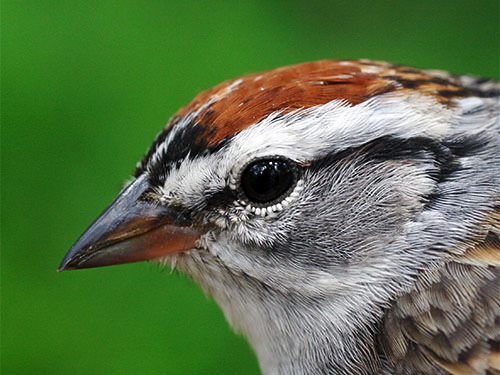
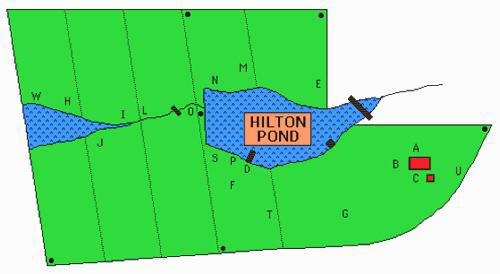
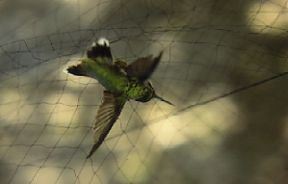 (Regardless of weather, we're careful to check nets frequently and remove birds such as the Ruby-throated Hummingbird a
(Regardless of weather, we're careful to check nets frequently and remove birds such as the Ruby-throated Hummingbird a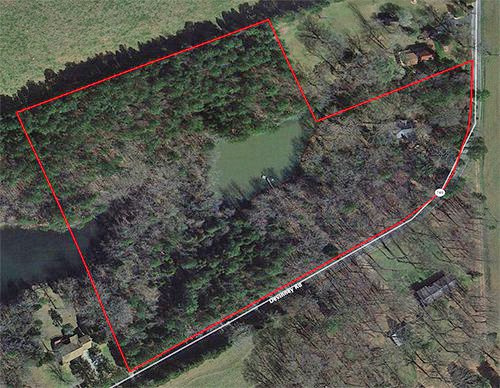
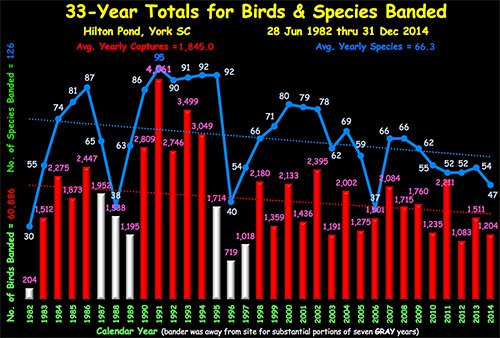
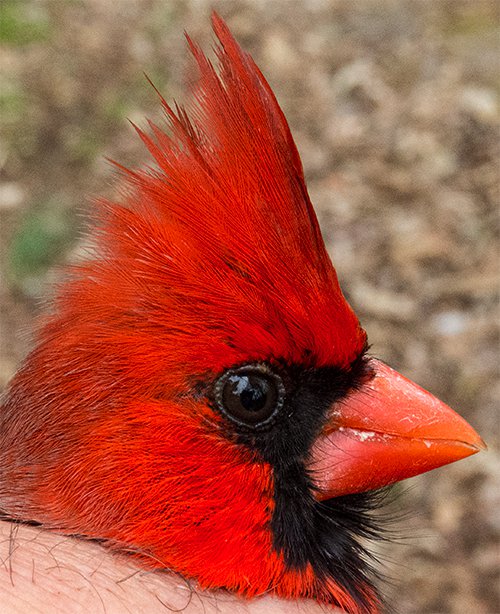


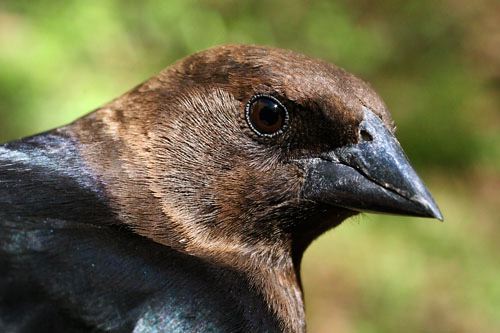

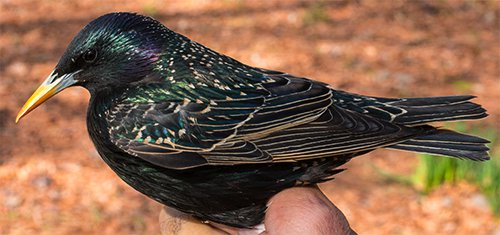


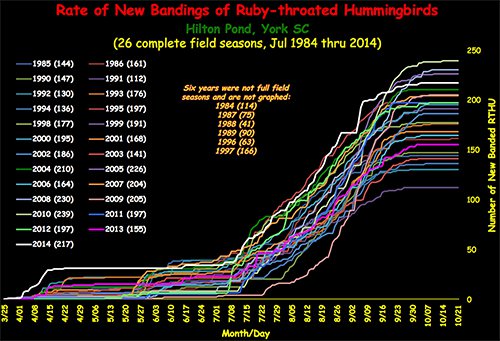
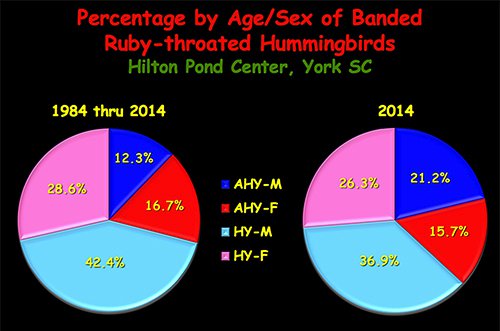
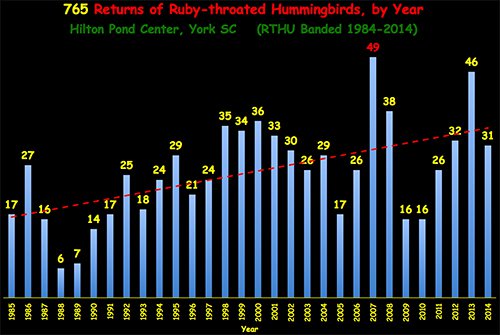

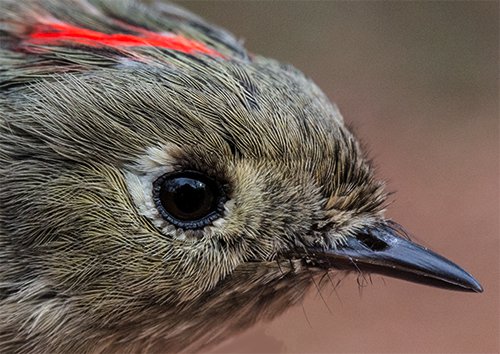







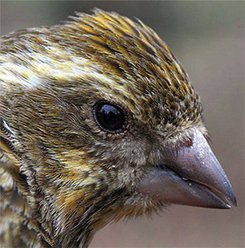
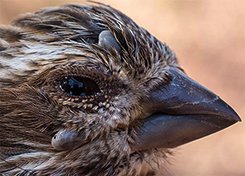
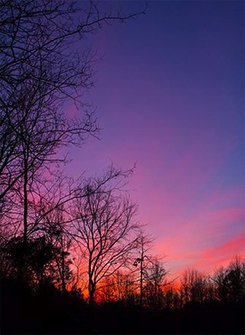
 Oct 15 to Mar 15:
Oct 15 to Mar 15: